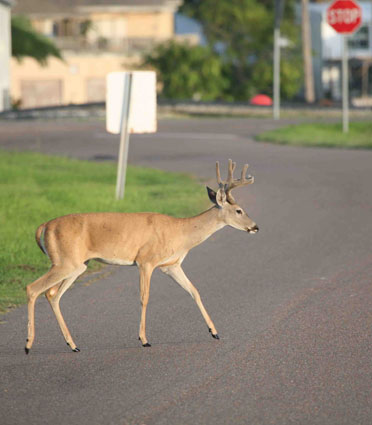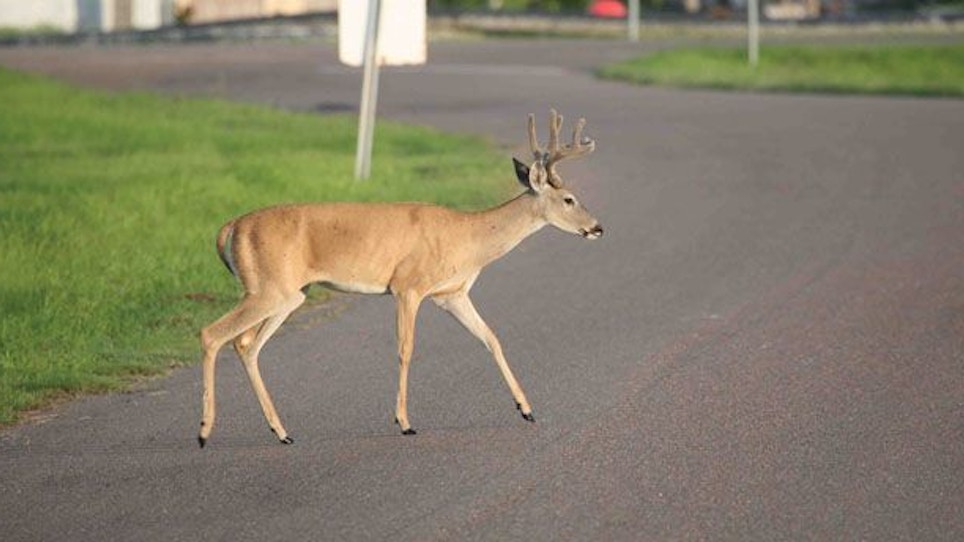 Deer have learned to thrive in human habitat. As cities and subdivisions spread into traditionally rural areas, deer aren’t displaced; they’re simply absorbed into the country lifestyle of people trying to escape the hectic concrete world of cities. With ample food supplies and generally little threat from predators or firearm hunters, deer in such areas have proliferated, and bucks have grown to record-book size.
Deer have learned to thrive in human habitat. As cities and subdivisions spread into traditionally rural areas, deer aren’t displaced; they’re simply absorbed into the country lifestyle of people trying to escape the hectic concrete world of cities. With ample food supplies and generally little threat from predators or firearm hunters, deer in such areas have proliferated, and bucks have grown to record-book size.
Ten years ago this sort of urban sprawl usually came along with the posting of “No Hunting or Trespassing” signs. But even office-tower yuppies with no love for hunters are learning that too many deer living on their well-manicured rural estates is not only bad for petunias, apple trees and tomato plants, but also for their BMWs, as deer/vehicle collision rates increase with the population.
The result of this interesting turn of hunting events is a windfall for some hunters, like ones living in and near the Twin Cities of Minneapolis-St. Paul, Minn., where hundreds of archers belong to the Metro Bowhunter Resource Base (MBRB). Thanks to a cooperative effort with the cities, surrounding suburban communities, police and the state DNR, members are allowed to bowhunt whitetails in areas where firearms hunting is not allowed. Bowmen who join the MBRB (non-residents are invited, too) must take a lengthy bowhunter education class, pass a bowhunting proficiency test and pay a modest fee, and then they’re eligible for permit drawings for special Twin Cities hunts. Some hunts are conducted on city parks; others are held in small suburban communities where deer have become such a nuisance that homeowners contact the municipalities, which contact the state DNR, which in turn calls the MBRB.
The results are outstanding. Over the years a number of record-book whitetails have been taken on Twin Cities urban deer land. But the heavyweight buck taken by Deb Luzinski in late October, 2006, is in a class by itself. The veteran 38-year-old whitetail hunter from the town of Woodbury was participating in a special herd-management MBRB hunt on Otter Lake Regional Park in Ramsey County. She hung a tree stand about noon, and that afternoon a monster whitetail showed. She made a perfect 17-yard shot on the 200-pound deer. The non-typical buck is one of the largest ever taken in Minnesota, having 24 points and scoring an astounding 225 Pope-and-Young-Club points.
The Benefits
The MBRB has been so successful in the Twin Cities that other metro areas with deer control problems, including Detroit, have sought their assistance in setting up similar programs. Still, anti-hunters and some city councils don’t always understand the viability of hunting as a means of deer control, or the need for such urban outdoor recreation. Often big cities with big deer-herd problems completely avoid the issue.
One Chicagoland hunter I know collects rutting bucks as they cruise out of a suburban forest preserve and cross his backyard on their way to a neighboring grass field, which happens to be a local Little League diamond. Instead of sitting in a tree stand, he actually sits on a dove stool in his heated garage with the back door open. He gets a good buck every year, including a 135-inch P&Y buck.
Obviously, much of the very best urban deer hunting is available on private land. But there are places to go if you think creatively.
Golf course communities in large suburban settings are often jammed with whitetails, so much so that greens keepers and landscapers have difficulty keeping greens green and flowers blooming around otherwise well-maintained clubs. I know of many P&Y bucks arrowed in woodlots bordering urban golf courses, and crews in charge of such links are only too happy to see a herd thinned. Obtaining permission to bowhunt from a golf club or a homeowner on the club isn’t nearly as difficult as one might believe, especially during late autumn and winter when golfers are huddled closer to the fire than to a sand trap.
I have one Virginia friend who hunts near links beside a large country-club home owned by a pal’s grandmother. His favorite tree stand is within sight of the home, and the lady waves to him each morning shortly after sunrise.
She gets a kick out of seeing me in that tree stand while drinking her morning tea, and gets more excited than me when I stand and shoot a deer,” he explains. “Twice I’ve shot a buck, looked over toward her house, and saw her giving me the ‘thumbs up’ sign, knowing I’ve taken a deer. She still likes seeing whitetails around her home and golf course, but she couldn’t grow flowers in her garden. First year there she was so glad I was hunting deer she brought hot tea and homemade cookies out to my stand. I was going to explain to her why that wasn’t such a good idea, but then I figured the deer were used to her, and smelling human scent. So I kept my mouth shut.
Hasn’t seemed to hurt much. I took a 9-point buck there last November, during the rut, that scored 119 inches.”
While getting a buck of record-book size is every hunter’s goal, it’s not realistic in every urban hunting region. Still, the hunting in suburbia is great and access is easier than you might first believe.
One Wisconsin pal, for example, relates the story of a girlfriend telling him about a neighbor outside Milwaukee who was having trouble from “deer pests.” My buddy didn’t think much about it until his girlfriend kept mentioning the “deer pests,” then described a heavy-beam 10-pointer she saw one night in that same neighbor’s front yard. The next day the hunter went to the lady’s house, knocked on her door, and when she opened it he asked if she was the person having trouble with deer “pests.”
“Why, yes,” she replied excitedly. “Those deer are terribly destructive. They’re really an awful nuisance.”
“Well, ma’am,” he replied smiling wryly, holding his hat in his hands. “I’m the Orkin man, and I’m here to solve your pest problem with my bow.”






